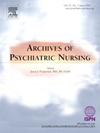The relationship between problematic media use and sleep problems in preschool children: A descriptive cross-sectional study
IF 2.2
4区 医学
Q1 NURSING
引用次数: 0
Abstract
Objective
This study aimed to investigate the relationship between problematic media use and sleep problems in preschool children.
Methods
A total of 152 children and their parents participated in this descriptive and cross-sectional study. Data were collected through the Descriptive Information Form, the Children's Sleep Habits Questionnaire (CSHQ), and the Problematic Media Use Measure-Short Form (PMUM-SF).
Results
The mean age of children included in the study was 5.12 ± 0.62 years. The most frequently used screen-based media device was television (n = 71; 46.7 %). The average screen time was 105.00 ± 63.51 min, with a range of 10–300 min. A statistically significant, positive correlation was found between the Problematic Media Use Measure-Short Form and Children's Sleep Habits Questionnaire scores. Additionally, it was determined that screen time had a statistically significant positive correlation with the Problematic Media Use Measure-Short Form and Children's Sleep Habits Questionnaire scores. Furthermore, problematic media use was determined to significantly affect sleep problems.
Conclusion
The study's results confirmed that children's problematic media use had a statistically significant effect on their sleep problems. As children's problematic media use levels increased, their sleep problem levels increased. Our study also showed that as screen time increased, the level of problematic media use and sleep problems increased. To prevent problematic media use and sleep problems in children, intervention programs focused on limiting children's screen time and improving their sleep quality are recommended.
学龄前儿童不良媒体使用与睡眠问题的关系:一项描述性横断面研究
目的探讨学龄前儿童问题媒体使用与睡眠问题的关系。方法对152名儿童及其家长进行描述性和横断面调查。通过描述性信息表、儿童睡眠习惯问卷(CSHQ)和问题媒体使用量表(pmm - sf)收集数据。结果纳入研究的儿童平均年龄为5.12±0.62岁。最常使用的屏幕媒体设备是电视(n = 71;46.7%)。儿童平均屏幕时间为105.00±63.51 min,范围为10-300 min。问题媒体使用量表-短表与儿童睡眠习惯问卷得分呈显著正相关。此外,屏幕时间与问题媒体使用量表-短表格和儿童睡眠习惯问卷得分有统计学上显著的正相关。此外,有问题的媒体使用被确定为显著影响睡眠问题。研究结果证实,儿童有问题的媒体使用对他们的睡眠问题有统计学上的显著影响。随着儿童问题媒体使用水平的增加,他们的睡眠问题水平也会增加。我们的研究还表明,随着屏幕时间的增加,有问题的媒体使用和睡眠问题的水平也在增加。为了防止儿童有问题的媒体使用和睡眠问题,建议采取干预措施,限制儿童看屏幕的时间,提高他们的睡眠质量。
本文章由计算机程序翻译,如有差异,请以英文原文为准。
求助全文
约1分钟内获得全文
求助全文
来源期刊
CiteScore
3.70
自引率
0.00%
发文量
131
审稿时长
160 days
期刊介绍:
Archives of Psychiatric Nursing disseminates original, peer-reviewed research that is of interest to psychiatric and mental health care nurses. The field is considered in its broadest perspective, including theory, practice and research applications related to all ages, special populations, settings, and interdisciplinary collaborations in both the public and private sectors. Through critical study, expositions, and review of practice, Archives of Psychiatric Nursing is a medium for clinical scholarship to provide theoretical linkages among diverse areas of practice.

 求助内容:
求助内容: 应助结果提醒方式:
应助结果提醒方式:


